Army/Navy Recruitment Guide - 1917
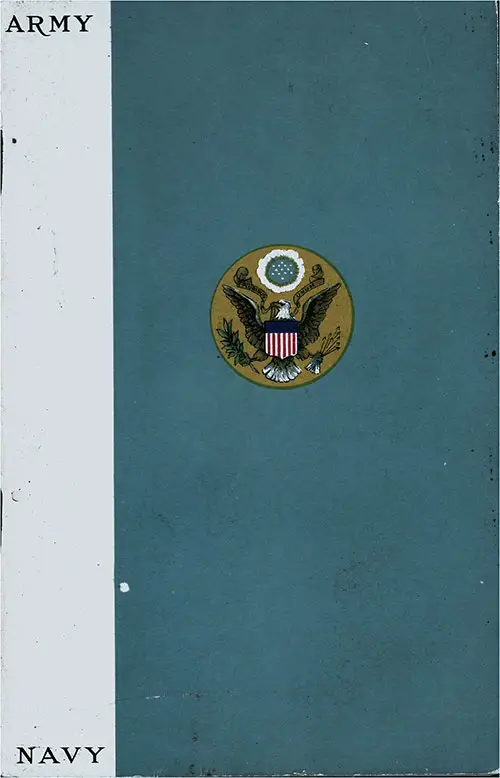
Front Cover, Army/Navy Recruitment Guide for World War I, Prudential Insurance Agency, 1917. GGA Image ID # 18d4d78fdd
WWI Army / Navy Recruitment Brochure. Circa 1917, Published by the Prudential Insurance Agency. 32 Pages.
Contents:
- Forward-Purpose of Brochure
- Infantry
- Cavalry
- Engineers
- Signal Corps
- Aviation
- Weapons
- Artillery
- Marine and Sailor
- Dreadnaughts
- Torpedo Boat Destroyers
- Submarines
- Scout Cruisers
- Medical Department
- What Every Soldier Ought To Know
The Army the Navy of the United States of America - 1917 Copyright. 1917
The Prudential Insurance Company of America Newark, New Jersey – 1917 - Copyright. 1917
"—We shall fight for the things which we have always carried nearest our hearts—for democracy, for the right of those who submit to authority to have a voice in their governments, for the rights and liberties of small nations, for a universal dominion of right by such a concert of free people as shall bring peace and safety to all nations and make the world itself at last free." - Woodrow Wilson
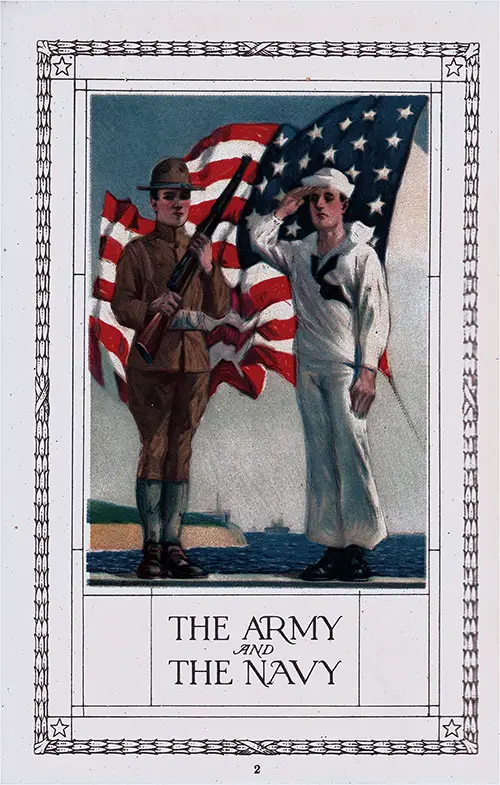
Painting of Army Soldier and Navy Sailor Saluting the American Flag. Army/Navy Recruitment Guide for World War I, 1917. GGA Image ID # 18d549920c
Foreword
With millions of young men registered in the United States for national service, it is proper, perhaps, that a little booklet such as this may be put forth illustrative of the various branches of Military and Naval life to which these youth of the land are assigned to duty.
It has been prepared with much care and rigid respect for accuracy in detail and in a statement and has been passed upon by our government's War and Navy Departments.
It is hoped that these accuracies and these facts may prove of interest and make us look with more pride upon a flag whose honor has been untainted since it first fluttered to the dawn and the splendor of whose hues has everywhere been accepted as a covenant representing neither aggression nor conquest nor dominion.
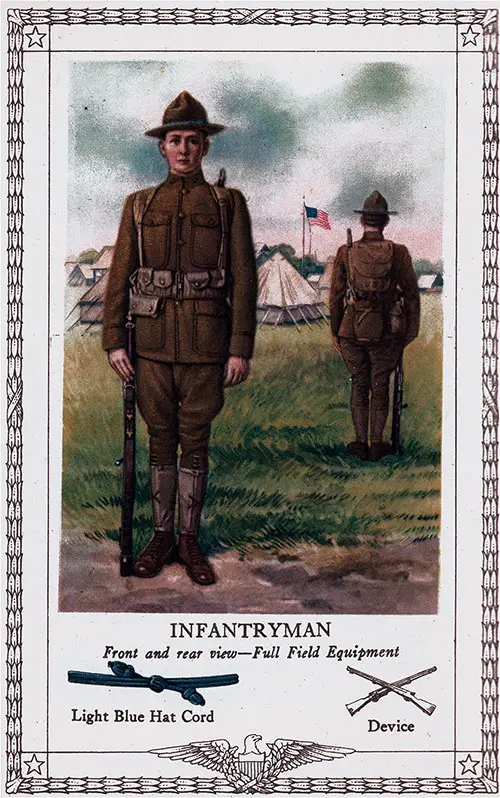
Infantryman (Front and Rear View). Army/Navy Recruitment Guide for World War I, 1917. GGA Image ID # 18d56e292c
Infantry
The infantry is, in a sense, the army. Other arms of the service—the cavalry, artillery, etc. -- are auxiliary. They are for the purpose of enabling the infantry to win battles.
There are about 26,000 men in an army division. this total the infantry numbers about 19,000, the cavalry, artillery, engineers, sanitary train, signal corps, being about 7,000.
On the march, the division extends along fifteen miles of road and moves at the rate of two to two and one-half miles an hour. At the end of every fifty minutes, the division halts, and the men are allowed ten minutes rest, with an hour for lunch.
A division is the smallest tactical unit. In the words of General Wood, it is the smallest unit that can be called an army. However, our army is not organized into tactical, having been distributed widely among our forty-nine mobile army posts.
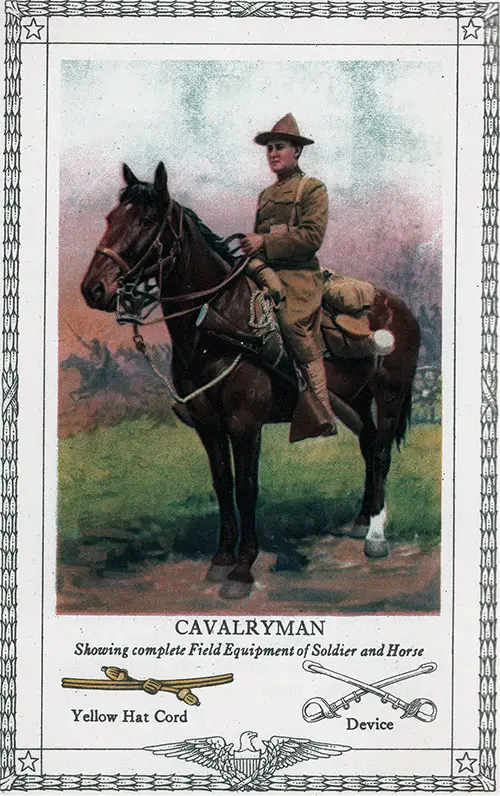
Cavalryman Showing Complete Field Equipment of Soldier and Horse. Army/Navy Recruitment Guide for World War I, 1917. GGA Image ID # 18d59e9ee9
Cavalry
The cavalryman, or "trooper," because of the open formation of most cavalry movements, must have plenty of dashes and individual resourcefulness.
He must, of course, be a horseman of more than ordinary skill. He must be able to vault into the saddle from the ground and know how to care for his horse.
The arms of the cavalryman are the saber, rifle, and automatic pistol. He is required at times to dismount and fight on foot, a phase of service in which the cavalry of this country excels.
The division on the march is preceded by a regiment of cavalry, which reconnoiters and screens the movements of the division by preventing the enemy from reconnoitering.
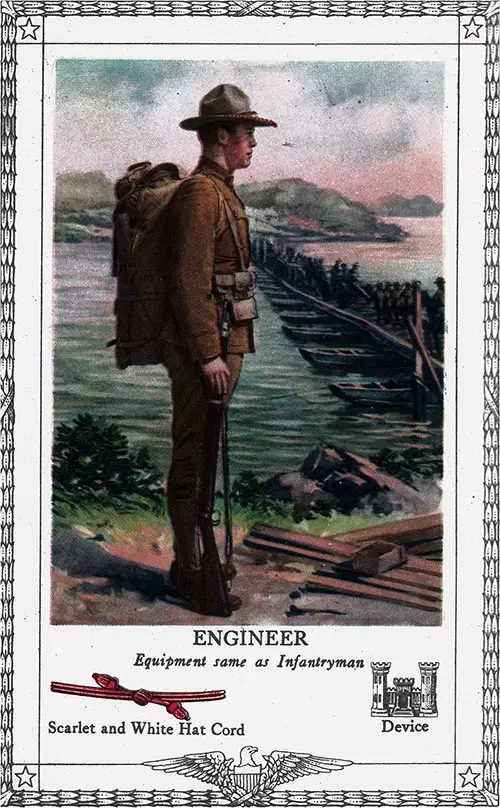
Engineer Showing Equipment Same as Infantryman. Image Also Shows Scarlet and White Hat Cord and Device. Army/Navy Recruitment Guide for World War I, 1917. GGA Image ID # 18d5a2915e
Engineers
The engineer often receives a part of his training in civil life. He must, however, also have specialized knowledge for army service.
He solves problems of camp location and drainage; constructs cover for the men in the trenches; erects field fortifications; creates obstructions for the enemy and clears them away for his own division; builds railroads, bridges and repairs roads, does all pioneering work, and, in short, actually performs and superintends all construction plans of All the army.
Army engineers built the Panama Canal.
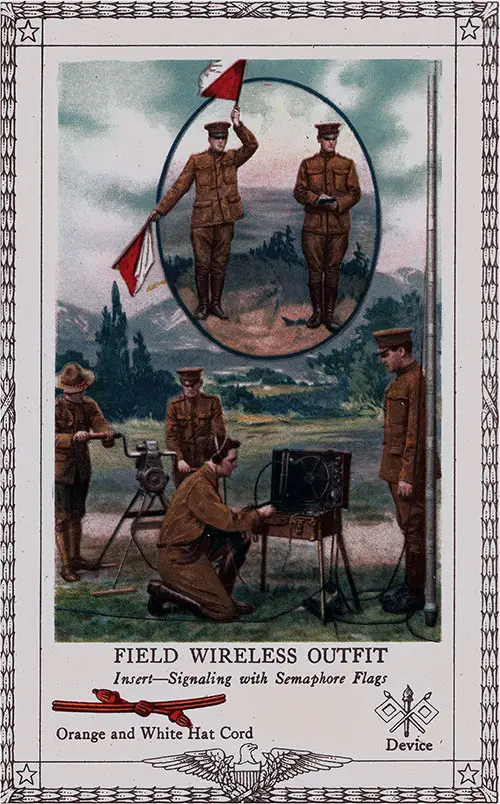
Field Wireless Outfit - Insert—Signaling With Semaphore Flags. Army/Navy Recruitment Guide for World War I, 1917. GGA Image ID # 18d5a2bbf7
Signal Corps
The signal troops are the nerves of the division. The commander of the division can communicate with any part of it by telephone on the march.
A signal battalion furnishes communication by flag signals, heliograph, acetylene lamps, semaphore, field telephone, field telegraph, and wireless.
It is composed of 173 men, with 180 animals. It carries a shop wagon, two instrument wagons, six-wire carts, twenty miles of wire, and four radio sections.
The Signal Corps has complete charge of the aviation, telegraph, wireless telegraph, telephones, photography, and ordinary signaling methods. In this branch are thousands of men drawn from the electrical field.
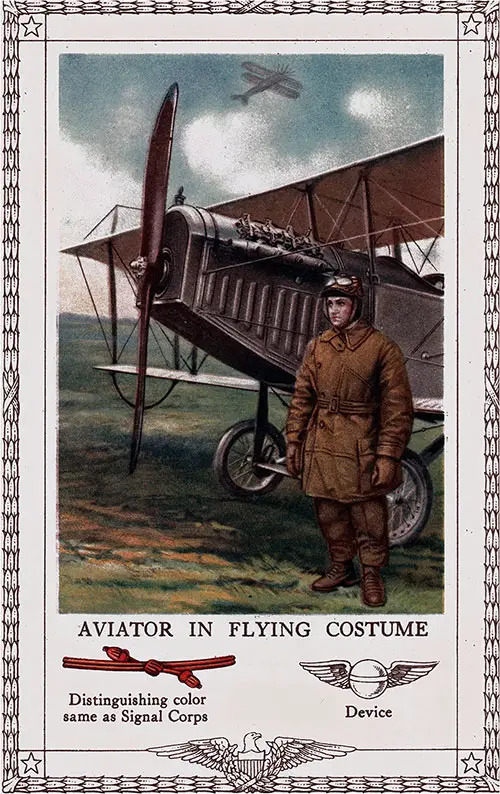
Aviator in Flying Costume. Army/Navy Recruitment Guide for World War I, 1917. GGA Image ID # 18d5acf32d
Aviation
The Aviation Corps, listed as aeroplane service, has supplanted the old days' cavalry as the eyes and ears of the army.
Its importance in this service has been but recently demonstrated, and so greatly has this importance been valued that all nations have contracted for thousands upon thousands of these birds of the air.
Signaling, of course, is done from aeroplanes, but greater duties of the aero squadron are scouting and directing artillery fire. The Aviation Corps is part of the regular Army Signal Corps.
Weapons of War
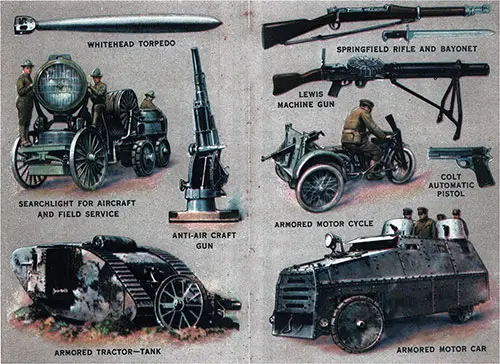
Weapons of War. Army/Navy Recruitment Guide for World War I, 1917. GGA Image ID # 18d5d64ee3
(Left To Right, Top To Bottom) :
- Whitehead Torpedo
- Searchlight for Aircraft and Field Service
- Anti-Air Craft Gun
- Armored Tractor—Tank
- Springfield Rifle and Bayonet
- Lewis Machine Gun
- Armored Motorcycle
- Colt Automatic Pistol
- Armored Motor Car
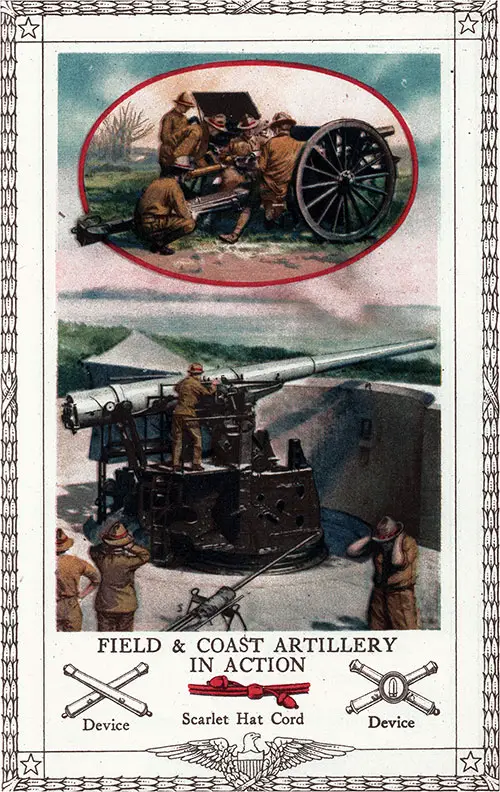
Field & Coast Artillery in Action. Army/Navy Recruitment Guide for World War I, 1917. GGA Image ID # 18d64ab59a
Artillery
AT the present time, we hear much about the coast artillery, which is made up of fixed or stationary cannon, set in batteries made up of two or more guns within proper fortifications on various strategic points where they may effectively oppose naval attacks.
Artillery for fortifications is of a character similar to coast artillery. Siege guns are of as heavy a caliber or power as the guns used in fortifications but are mounted so that they may be moved by motor power or train from one point to another.
Field, horse, and mountain artillery are exactly what their names imply— the mobile, adaptable guns of an army.
Machine guns do not form part of the artillery. Picked men are detailed from each regiment of infantry to operate the machine guns.
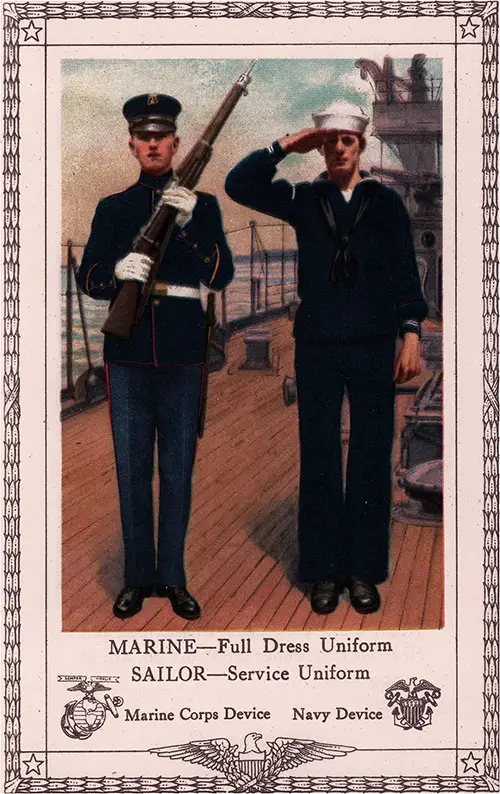
Marine—Full Dress Uniform; Sailor—Service Uniform; Marine Corps Device | Navy Device. Army/Navy Recruitment Guide for World War I, 1917. GGA Image ID # 18d6cc6b94
Marine and Sailor
IN a 27,000-ton battleship is a crew of some 1,100 men. In battle, some 400 or more men are engaged in serving the main battery guns; possibly twenty actually see the result of the fire. In the engine rooms are nearly 300 more men upon whose efficiency depends in no less degree the success of the battle.
The Marines are, in effect, sea-going infantry. They are called into action when a seaport must be quickly seized or a legation in a foreign country protected. A battleship carries two officers and about seventy men of the Marine Corps.
There are in the Navy, in peacetimes, Sailors, Marines, and Officers. In our Naval Militia are enlisted, men and officers.
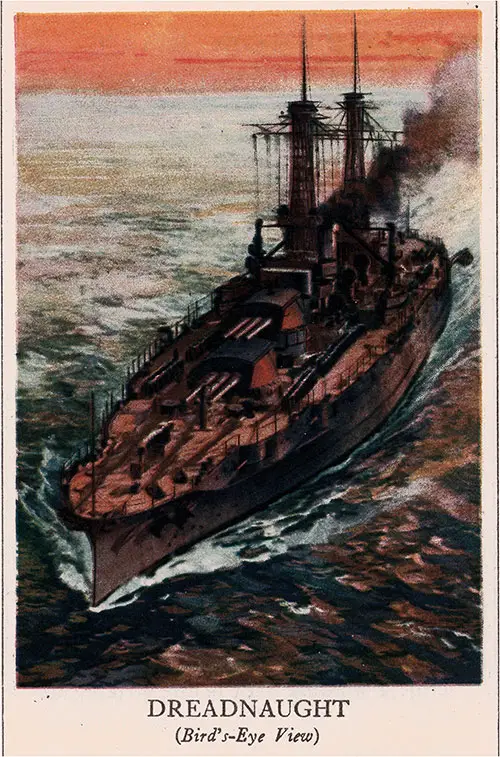
Dreadnaught - (Bird's-Eye View). Army/Navy Recruitment Guide for World War I, 1917. GGA Image ID # 18d6a9711f
Dreadnaughts
Naval strength is purely comparative.
At the Spanish War outbreak, we had but five battleships, two armored cruisers, and twenty-nine smaller cruisers. Our program is now contemplated that by 1921 we shall have fifty-two battleships, six battle cruisers, and forty-one cruisers.
The term "super dreadnaught" has been coined for battleships of 25,000 tons and speed of from twenty-one to twenty-five knots. Similarly, the term "pre dreadnaught" designates the other battleships of not over 16,000 tons.
Our Nevada and Oklahoma are 27,500-ton ships, as are England's Queen Elizabeth and Warspite. Our Arizona and Pennsylvania, just completed, are of 35,400 tons. Our Idaho, Mississippi, and New Mexico, under construction, are of 32,000 tons.
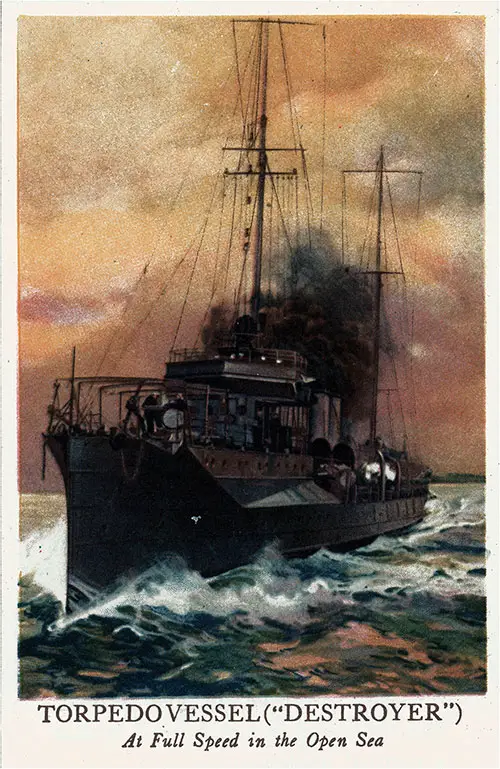
Torpedo Vessel ("Destroyer") - at Full Speed in the Open Sea. Army/Navy Recruitment Guide for World War I, 1917. GGA Image ID # 18d736c25c
Torpedo Boat Destroyers
The torpedo boat, a small craft of from fifty to about 300 tons displacement, is being largely displaced by the destroyer, a similar vessel of 350 to 1,100 tons. Both types are armed with small guns as well as torpedo equipment, and their speed varies from nineteen to thirty-three knots. They are important as raiders and for screening naval operations by trailing thick clouds of smoke.
The torpedo is the most deadly missile in naval warfare. A hollow steel projectile of a small pleasure boat's size contains the most intricate and delicately adjusted mechanisms for propelling it, steering it, and timing the explosion.
By means of the gyroscope, the torpedo may be made to describe a winding path before striking its target. By means of wireless methods, the torpedo has been made even more destructive.
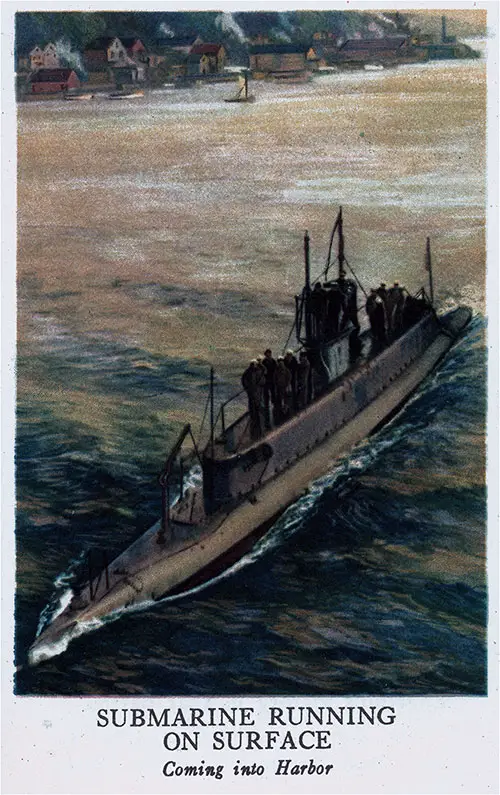
Submarine Running on Surface - Coming Into Harbor. Army/Navy Recruitment Guide for World War I, 1917. GGA Image ID # 18d79605ea
Submarines
Like the aeroplane, the submarine is undergoing changes so rapidly and usually so secretly that it is difficult to make statements of fact about it.
It has been claimed that a crew of eighteen to twenty-four can live for three or four weeks on the supply of air in its containers, without coming to the surface.
The submarine is submerged partly by the flooding of its ballast tanks with seawater and partly by the action of its horizontal rudders when in motion. Its lowest safety depth is 200 feet; below that, it will collapse from the pressure of the water above it.
It is said that a submarine can aim (through its periscope), discharge a torpedo, and dive, in five seconds. The submarine is a raider rather than a tactical implement.
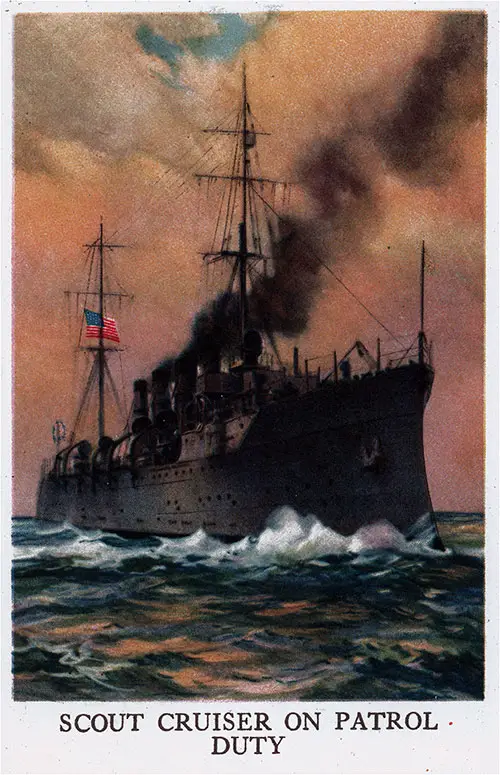
Scout Cruiser on Patrol Duty. Army/Navy Recruitment Guide for World War I, 1917. GGA Image ID # 18d7b634ee
Scout Cruisers
The old type of armored cruiser, a vessel of 9,000 to 16,000 tons, has way given on the one hand to the "battle cruiser," a vessel of 57,000 tons and over, and on the other hand to the "scout cruiser," of 5,000 tons or less, and built for great speed.
At the outset of the great war in 1914, Germany had to build four new battle cruisers of 28,000 tons each, and Japan four of 27,500 tons each. England has ten. The United States at that time, had none, but four were started in 1916.
The battle in which the Bluecher was sunk was fought on both sides by battlecruisers. England's victory in that battle well demonstrated the value of speed in battle cruisers (twenty-five to thirty knots).
The latest Navy bill provides for ten "scout cruisers" for the United States.
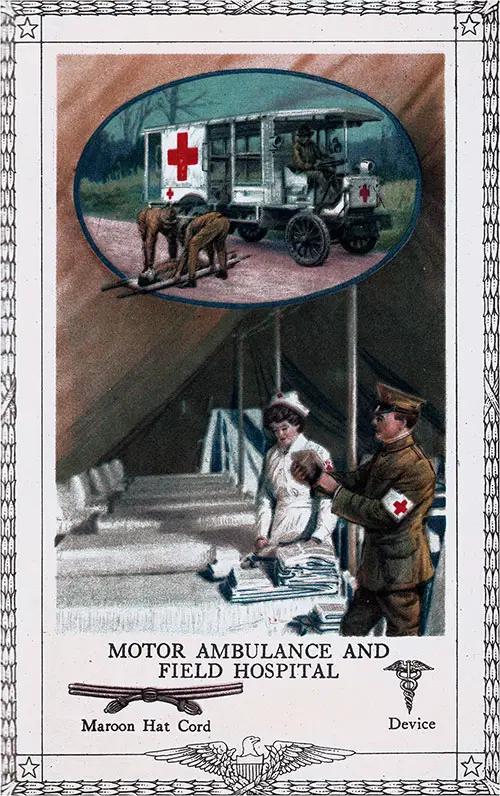
Motor Ambulance and Field Hospital. Army/Navy Recruitment Guide for World War I, 1917. GGA Image ID # 18d7d2fb87
Medical Department
The Medical Corps' duties are of great importance, and looking after the wounded with the aid of the Red Cross is but a part of them.
The health of the army and the prevention of disease, inspection of food and water supply, and other camp sanitation are in its jurisdiction.
The Medical Department is supplemented by the Hospital Corps, the Nurse Corps, the Dental Corps and the Veterinary Corps. The Red Cross is an international badge respected by all forces.
What Every Soldier Ought To Know
The object to be aimed at in the training of a soldier is to make him, in mind and body, a better man than his adversary on the field of battle. Fitness for war is the only thing that counts, and every soldier should school himself to keep this constantly in mind.
His first duty is to acquire a soldierly spirit. This will help him to bear fatigue, privation, and danger cheerfully will give him confidence in himself, his officers, and his comrades, and will produce such a high degree of courage and disregard of self that, in the day of battle, he will use his brains and his weapons coolly and to his best advantage.
A soldier must learn to be proud of his profession and particularly so of his own regiment or corps.
